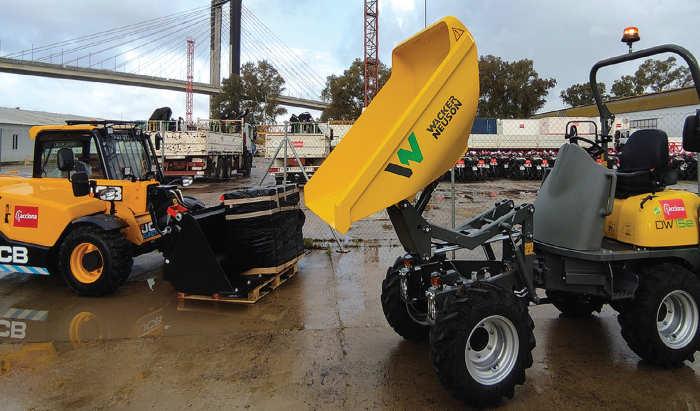
46 minute read
Telescopic Handlers
Doing the heavy lifting
From ACCIONA to Volvo Penta and Manitou, telescopic handler companies are introducing innovative alternatives to fight climate concerns.
WITH THOUSANDS OF buildings erected in the congested streets of a city each year, there’s no room for complacency as contractors endeavour to minimise the disruption they bring to the neighbourhood. Sometimes, there is little room for tower cranes either –but, thanks to the powerful reliability offered by a Volvo Penta D5 engine and a Magni RTH 6.46 rotating telescopic handler, companies have found the perfect alternative.
Unlike a crane, the Magni RTH 6.46 rotating telescopic handler can be set up within minutes and easily moved, perfectly combining compact mobility and maneuverability with its status as one of the highestreaching telehandlers in the world. Impressively, it can lift a maximum 6 t, or 2.5t to just under 46 m, from where a spider crane can distribute the loads to the higher floors. It can be used for hoisting everything from plywood sheets to the concrete pump and bringing the garbage back down. It is estimated that Magni will make approximately 3,000 lifts over a 13month build, including moving a total 900 t of steel.
This sort of intensive use is far from unusual for Magni’s telehandlers, so when it came to choosing an engine that could reliably power the RTH 6.46, its engineers instantly thought of partnering with Volvo Penta.
ACCIONA, a global company providing regenerative solutions for a decarbonised economy has purchased four telescopic handlers and two rotating dumpers, which will mainly be used in urban construction projects. As part of its commitment to mitigating climate change, ACCIONA has recently acquired electrical machinery through its Asset Management Department for use in the construction projects that the company undertakes all over the world. This pilot project, part of the company’s decarbonisation plan, makes ACCIONA the first Spanish construction company to invest in this kind of electrical machinery. Thanks to their 100% electrical operation, great improvements are made in reducing pollutant emissions and noise levels on site.
In line with the latest scientific studies on climate change, the company has undertaken to reduce direct emissions by 60% between 2017 and 2030, aiming to limit global warming to no more than 1.5ºC above preindustrial levels.
Overall, it is estimated that the use of this electrical machinery could reduce up to 100 tonnes of CO2 emissions.
Currently holding the spotlight in the telescopic handler market is Manitou, as it recently launched a new addition to its heavyduty telehandler range at Electra Mining Africa. The MHTX 11250, a first of its kind on the African continent, offers a capacity of 25 t and a maximum lifting height of 11 m. This combined with a fuel efficient, high torque, 211 hp twinturbo engine makes it an ideal solution for all types of maintenance and servicing activities on a mine site.
The company has not been adverse to climate concerns either, as the new engine –coupled to a hydrostatic transmission –boasts a 15% fuel saving figure, ensuring that the machine can efficiently handle heavy and bulky loads on all terrain.
The MHT range is also available in 9, 13.5, 16 and 20 t configurations which are now being stocked for the African markets and come with a wide range of attachments available including forks, hooks and winches, personnel cages as well as tyre, cylinder and pipe handlers. For maximum comfort, this machine is equipped with a panoramic cab, easy step access, JSM joystick and brandnew colour touchscreen display with dynamic load charts.
In addition to the large MHTX 11250 telehandlers, Manitou also showcased their MRT rotating telehandler range as well as their MTX 733 and MHTX 790 mining specification telehandlers, offering lifting heights of up to 7 metres and 3.3 t and 9 t capacity respectively. ■
ACCIONA has purchased four telescopic handlers to be used mainly for urban construction projects.
Pontchateau now even more a major asset for Bobcat
TELEHANDLERS HAVE BEEN part of Bobcat’s Pontchateau site plant in LoireAtlantique in France for more than half a century.
All Bobcat rigid telehandlers for the world market are manufactured here, including 29 models split between ranges for the construction and agricultural markets.
“In 2016, as our logistics capacity reached saturation and demand grew, Bobcat defined a threeyear expansion plan for the facility, representing four million euros of investment," explains Jerome Miermont, site director for the Bobcat Pontchateau facility.
Completed in 2019, with the addition of 13,000 sq m of extra space and a new 1500 m2 plus logistics building, these developments have made it possible to meet the effects of substantial growth in the brand’s activity (+75% between 2017 and 2022). This was also accompanied by a reorganisation of the manufacturing process.
For the telehandlers, the journey always starts in the design office. This office has a team of 40 employees operating from Pontchateau, together with another team based in the Czech Republic, at the Doosan Bobcat European headquarters.
On the production line, the machines start to take shape during the mechanical welding operations, which are strategically organised in two lines: one for the boom, and the other for the frame. After the steel parts have been laser cut, they are bent into the right shape for example, to form the two halfsections of the boom in U form, after which the next step is welding. "To optimise production, we have equipped ourselves with two larger robots, each of which welds all the frames, saving 30% in time. The last robot, representing an investment of 850,000 Euros, arrived last September," Jerome Miermont explains.
The various parts of the telehandlers are then sent to the blast chamber for shot blasting, before being painted. The staff carry out a detailed technical procedure (priming, fading time, lacquer application and oven drying) to ensure a highquality finish.
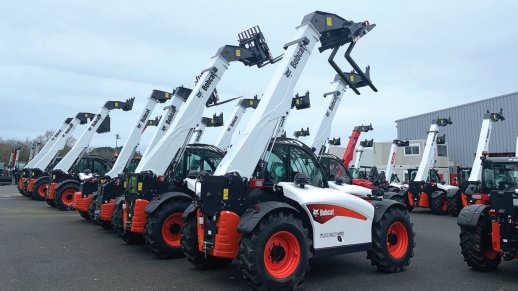
Up to 17 machines per day The assembly line is organised around 58 stations. To save time and space, a team in the kitting workshop has prepared the necessary components for each station in advance. On the subassembly line, various machine components (the engine nacelle, the cab etc.) are assembled to gradually build the machine on the main line, which alone comprises 17 different stations. Even before the tyres are fitted, the carriage is filled with oil and programmed. This is followed by the fitting of the mudguards, a performance test and the installation of the tyres. The final assembly station is reserved for the installation of the hood and the stickers, then the machine goes through a test phase (static and dynamic) for four hours.
Up to 17 machines can be assembled daily. "Last year we produced 2658 machines. This is a record number, well above the planned target of 2455 units," Jerome Miermont adds. But with an estimated annual production capacity of 3500 machines in 2022, there is still space for growth. The Pontchateau plant intends to double its activity by 2025.
The plant in Loire‐Atlantique, France for Bobcat rigid telehandlers has given itself the means to go to the next level.
Genie telescopic boom lift combines performance and lower costs
WITH A LEADING unrestricted capacity and lightweight, efficient design, the Genie S80 J boom lift is not only wellsuited for nearly any workatheight task, it also is purposefully designed to lower ownership costs.
Earlier this year, eight Middle East access hire companies had a chance to see the S80 J firsthand, and inperson during Genie’s UAE S80 J Demo Tour. During the event, Genie team members provided demos that highlighted the quality and capabilities of the S80 J boom lift, shared information about how the boom could help rental companies maximise their profitability. Mark Pilford, regional operations manager at Access Rental Gulf, observed, “The reduced TCO is definitely a game changer, especially in the midsized booms that are challenged on rental rates. I will be able to improve my ROI and also differentiate the XC range with a better rental rate. And customers will benefit from a machine that is more affordable, especially if they do not require all the features of the XC range, yet gain an extra 70 kgs of work in the basket, along with the latest technology.”
The Genie S80 J boom lift features a leading unrestricted platform capacity of 300 kb (660 lb), 16.8 m (55 ft) of horizontal reach for access at the top of the envelope, and a 1.8 m (6 ft) jib, making it well suited for nearly all workatheight tasks in the 80 ft (26 m) range, including general construction, maintenance, inspection and painting. A singleenvelope, optimised design reduces overall inspection points and wearable components, speeding up inspections and reducing the time and expense of maintenance and repairs, resulting in a lower total cost of ownership.
Thanks to its extremely low machine weight, the S80 J has low ground pressure for a machine of this class size. It’s low weight also allows the S80 J to be equipped with the exclusive Genie 4point TraX™ system — making it the first and only 80 ft (26 m) boom lift to be available as a tracked option. Genie TraX provides exceptional terrainability and lower contact pressure for a smooth drive on rough ground conditions and reduced damage when operating on sensitive ground surfaces, such as wet grass, mud, sand and snow, as well as on harder, uneven gravel, rock, concrete or asphaltbased surfaces.
A high ground clearance of 36 cm (14 in) — or 41 cm (16.25 in) when equipped with TraX — the S80 J easily clear rocks, curbs, trailer breakovers and other daily obstacles, getting operators around jobsites more efficiently. Genie lifts and telehandlers can be found enhancing safety and improving productivity on jobsites worldwide. Genie consistently builds on its ability to consistently deliver superior quality for our customers.
Wirtgen Group makes sustainable road construction a reality
THE SUSTAINABILITY FOCUS of the Wirtgen Group was a central theme throughout its appearance at bauma in Munich, this year. Consequently, the spotlight among the world premiere machines and innovations was on batteryelectric tandem rollers from Hamm, the batteryelectric mini road pavers from Vögele, and the allelectric impact crusher from Kleemann. The two Wirtgen compact milling machines with comfort cabin, the Vögele Dash 5 generation road paver, and the Benninghoven REVOC system, a catalytic converter for asphalt mixing plants, also drew attention.
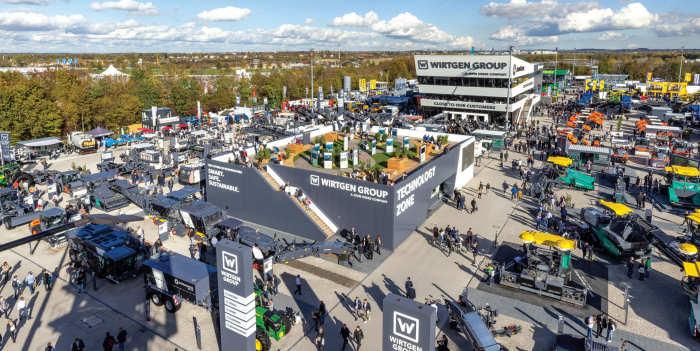
Production systems with ecological and economic savings potential
The Group presented production systems providing complete road construction solutions. Users benefit from the coordinated Wirtgen Group machine portfolio and the synergies generated by the alliance with John Deere. This also applies to the processing of quarry and recycling materials, where John Deere wheel loaders together with Kleemann crushers and screening plants form an integrated production system.
The Wirtgen Group presented its innovative powers at bauma, 2022.
Digitisation as a driver for greater sustainability in road construction
The Group highlighted digital solutions for its product brands that already make it easier for users to operate the machines and enable job site documentation. These solutions include the Wirtgen Performance Tracker, the new Wirtgen AutoTrac satellitebased steering system for wheeled soil stabilisers and wheeled recyclers, the new Smart Compact digital compaction assistant from Hamm, as well as the Vögele documentation and process optimisation tools, WITOS Paving Docu and Paving Plus.
In addition, the Operations Centre provided a glimpse of how entire jobsites can be planned, monitored and analysed in the future. The aim is to deliver real added value to customers with the help of telematics solutions, enabling them to implement their projects even more efficiently.
New Grove TMS800-2 boosts productivity with ‘big crane’ features
THE TMS800-2 ADOPTS technology and features from larger truckmounted and allterrain cranes, packaging them into an easily roadable 80 USt unit.
The crane can carry its full 14 t of counterweight and remain within axle and tyre limits without a falloff load. In areas with stricter roading laws, the TMS8002 can carry 9 t and remain under 50 t GVW (gross vehicle weight), and 12.5 t per axle while being in a taxi configuration. The absence of wing weights contributes to the crane’s slim 2.5 m travel width.
“Think of the TMS8002 as a lighter version of the TMS90002, sharing the same ergonomic cab and having interchangeable counterweights, but with a shorter boom, a maximum capacity of 80 t, and excellent roading capabilities,” said JJ Grace, Grove’s product manager for truckmounted cranes.
Photo Credit : Grove
The crane boasts a six‐cylinder turbocharged diesel engine. Firm foundation
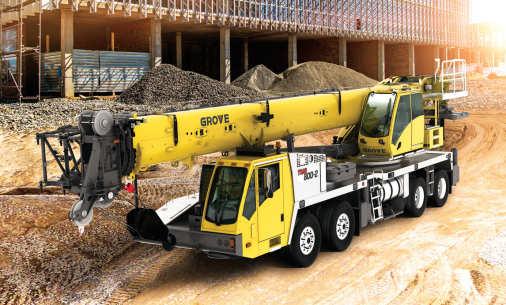
A new outrigger design makes the jobsite setup simpler and faster. The rear outrigger box is raised by just under 5 inches to improve the departure angle to 18°, while the front outrigger jacks are raised 3.5 inches to improve ground clearance.
Additionally, Grove’s MAXbase allows outriggers to be positioned asymmetrically, enabling the crane to be set up as close to the lift as possible. Smart sensors accelerate and enhance the stabilisation process, providing length sensing and an autolevelling feature.
More power and perks
The crane’s powertrain has also been upgraded, with the switch to a sixcylinder Cummins X12 turbocharged diesel engine boosting power output by 25 hp to 475 hp, and maximum torque from 1,550 lbft to 1,700 lbft.
Its aluminium carrier cab provides an improved level of comfort and ergonomics for the operator. Sightlines from the adjustable airsuspended seat are enhanced via a camera system that transmits realtime pictures from the rear or the righthand side blind spot to the incab display.
The operator’s access to the superstructure cab is simplified by five access/egress points around the chassis. Using the Crane Control System (CCS) platform, the dualaxis ergonomic joysticks allow fine control of the load from the comfort of the adjustable seat with hydraulic suspension.
CCS incorporates a fullcolour graphic display for better visibility and hosts a camera relay, giving the operator a bird’seye view of the deployment of up to 199 m of rope from the main hoist.

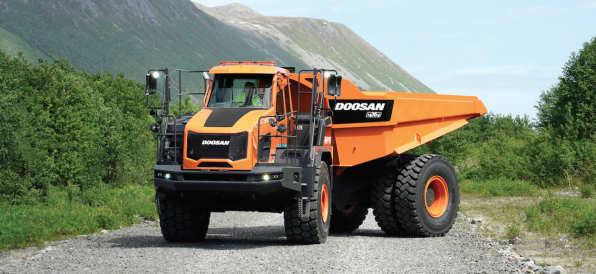
Doosan launches new articulated dump truck at bauma 2022
ONE OF SEVERAL world premieres from Doosan at bauma 2022 was the launch of the company’s new 4x4 articulated dump truck (ADT). Complementing the company’s standard, marketleading range of 6x6 ADT models, the new 4x4 version of the DA457 ADT is intended to compete with rigid dump trucks (RDTs) in the 40tonne class.
The new 4x4 DA457 ADT complements the current marketleading range of Stage V compliant 6x6 ADTs from Doosan, which includes the DA307 and DA457 models with payloads of 28 and 41 tonne, respectively.
In the new 4x4 ADT, the front truck and cab unit is the same as in the original 6x6 model, with modifications being made on the rear dumper unit only. Featuring a ZF EP8420 transmission, the 4x4 DA457 is a twoaxle ADT with twin wheels at the rear, and with a dumper section similar to that on RDTs in the 40tonne class.
Superior performance in difficult conditions compared to RDTs “With superior operation on poorer roads, smoother surfaces and steeper terrain, the aim of our new 4x4 machine is to challenge RDTs in the 40tonne class, by providing a dumper product that delivers
The 4x4 DA45‐7 ADT.
much more than RDTs,” said Beka Nemstsveridze, ADT product manager at Doosan.
As well as performing better in conditions that are tough for RDTs, the new 4x4 DA457 ADT has a width of less than 4 m to avoid the need for special transportation and offers a better turning radius than a comparable RDT. The shorter turning radius and the design of the rear dumper unit, which is more suited to carrying flat and heavy rocks, provide: • Climbing bigger inclinations than equivalent RDTs • Better performance than RDTs in wet and slippery conditions • Doosan’s 4x4 ADT does not need to stop working in heavy rain • More effective operation of the 4x4 ADT on compact sites, thanks to the short turning radius • The two axle 4x4 ADT design causes less ground disturbance than 6x6 configurations The new 4x4 DA457 ADT has been developed at the Doosan ADT plant located in Elnesvågen, Norway. As well as the advantages detailed above, the new Doosan Stage V 4x4 ADT provides excellent load carrying performance, fuel efficiency, enhanced controllability and high operator comfort, together with improved reliability, durability and reduced maintenance and servicing costs.
The new 4x4 DA45‐7 ADT performs better in conditions that are tough for RDT's For more on Doosan construction equipment, please visit: www.eu.doosanequipment.com
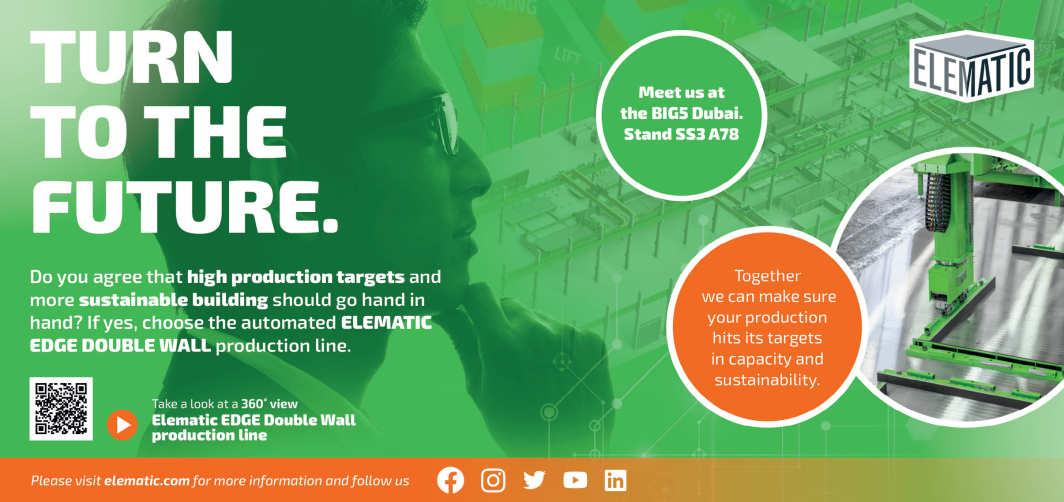
Caterpillar expands Tilt Rotate System for mini excavators
CATERPILLAR WORK TOOLS Division has announced new Tilt Rotate System (TRS) models for Cat 302.7 through 310 Next Generation Mini Excavators.
The new TRS4 and TRS8 S45 plus updated TRS6 models allow attached work tools to rotate 360 degrees and tilt 40 degrees sidetoside. This enables the machine to reach more work areas from a single position, while maneuvering tools over, under, and around obstructions when excavating, grading ditches, sorting recycle materials, or placing pipe. The new TRS models multiply the mini excavator’s versatility and are available in various configurations to match the application.
System design includes a top interface that connects the TRS to the carrier machine and a bottom interface that connects various work tools to the TRS.
All TRS models are standardised with an auxiliary TRSAux1 hydraulic function at the bottom. This allows for the installation of an integrated grapple module when the TRS model is attached to the carrier via the S type coupler system.
The TRS6 and TRS8 feature a standard TRSAux2 auxiliary port at the bottom to connect a variety for different hydraulic tools. Sensors for these TRS models work in combination with Cat mini excavator software and a variety of different external reference suppliers for 2D and 3D work applications.

Design benefits The compact design of the TRS4, TRS6 and TRS8 allows the mini excavator to maintain a nomaintenance lubrication system for the rotation system effectively distributes heat. The hightorque rotation system quickly positions work tools, and an integral selflocking mechanism enables digging at any angle required. Single/minimal grease points for TRS models delivers quick, efficient greasing of all joints requiring lubrication.
Integrated loadhold valves for the doubleacting tilt cylinder maintains holding pressures and prevents cylinder movement under load. Cylinder design features hardened pistons and maintenancefree bearings, and its scratchresistant, rustproof surfaces require no maintenance.
An integrated, dealerinstalled field control kit, which includes specially designed joysticks, suits all boomandstick combinations and provides intuitive control of the TRS and integral grapple. The TRS monitor informs the operator of the attachment’s position, and an engagement/disengagement sensor assures that work tools are secured via a safety locking mechanism with indicator. Activated by a joystick button, all TRS models offer a bucketshake feature to facilitate even spreading of materials.

TRS application TRS4 models are designed for efficient use by the Cat 302.7, 303, 303.5 and 304 Mini Excavators, while the TRS6 models are compatible with the Cat 305.5CR and 306 CR models. The TRS8 models are designed for use with the Cat 307.5, 308, 308.5, 309 and 310.
Cat 306 mini excavator with TRS6.
Photo Credit : Caterpillar
Herrenknecht at bauma 2022
AS A FULL-RANGE supplier of mechanised tunnelling technology together with its highly specialised subsidiaries, Herrenknecht supports the construction industry in all underground challenges.
At bauma the technology leader presented how the journey in tunnelling can progress with the help of technology.
Under the motto ‘Reconnect our joined ingenuity’, Herrenknecht presented the challenges of new underground missions and showcased innovative solution concepts at bauma 2022. With the expertise from worldwide lighthouse projects , Herrenknecht demonstrated how partners in mechanised tunnelling can move forward together safely, swiftly, and reliably.
Tunnel boring machines are complex engineered operating systems using stateof theart features and smart applications.Herrenknecht brings digitalisation for all involved experts straight forward: smart data analytics and virtual reality for training and onboarding.
Substantial renewable energy use and feasible power grids are among the key challenges for future infrastructure on which great public expectations rests. The underground construction industry is able to contribute increasingly environmentfriendly solutions. For example, trenchless methods secure fast and safe installation of underground cables with minimal impact on the surroundings. The Herrenknecht EPower Pipe is an ecofriendly choice when small diameter product pipes are to be installed at shallow depths. Recent years haveseen greatly increased offshore and marine constructions for renewable energy and futureproof coastal infrastructure. Herrenknecht Offshore Foundation Drilling technology can be employed on exceedingly rocky seabeds, enabling monopiling in populated sea ground while reducing sealifecritical noise emissions. The innovative technology opens up new terrain for offshore wind power, and also new construction capacities for bridge pier foundations, port facilities or tidal power.
Bentley Infrastructure Cloud offers improved productivity and quality
AT THE 2022 Year in Infrastructure Conference, Bentley Systems, Incorporated, the infrastructure engineering software company announced Bentley Infrastructure Cloud, its combination of enterprise systems that span the endtoend lifecycle and value chain of the world’s infrastructure. Bentley Infrastructure Cloud will enable better creation, delivery, and ongoing operation of better infrastructure, through complete and evergreen digital twins.
It encompasses ProjectWise, for project delivery; SYNCHRO, for construction; and AssetWise, for asset operations. These enterprise systems now leverage digital twin technologies, powered by iTwin, to open up data contained in engineering files through automated and intrinsic mapping to Bentley’s infrastructure schemas. Bentley Infrastructure Cloud provides user organisations with significant opportunities to improve collaboration, productivity, and quality.
Bentley Infrastructure Cloud comprises a datacentric, always on, always current, always accessible federated environment that persists and relates engineering data throughout the span of design, construction, and operations. Information mobility and semantic continuity across traditional boundaries through Bentley Infrastructure Cloud will help accelerate, among other advancements, modular design and design for constructability, and performancebased design.
Bentley’s senior vice president of enterprise systems Ken Adamson said, “Bentley Infrastructure Cloud stands for our commitment to connect everyone and everything in the infrastructure engineering value chain and extended project ecosystems. Infrastructure professionals deserve an evergreen digital twin environment for data that they can trust and act upon. I believe Bentley Systems is uniquely positioned to fulfill this requirement by virtue of the combined comprehensiveness of our ProjectWise, SYNCHRO, and AssetWise enterprise systems, our software’s intrinsic engineering fidelity, and our commitment to openness –including our unique resolve to semantically integrate the full range of relevant engineering file formats. The iTwin Platform, in becoming the robust foundation for unifying all of our software development, has been proven equal to this challenge.”

Powered by iTwin: ProjectWise leverages iTwin Capture to
Bentley Infrastructure Cloud provides user organisations with opportunities to improve collaboration, productivity and
integrate reality modeling data, increasingly the norm, to capture and monitor the digital context of designs, geospatially coordinated with engineering data.
It leverages Bentley’s infrastructure schemas to semantically align designfile data across multiple disciplines for comprehensive design reviews, and across all projects to understand dependencies, and to reuse datasets, including for machinelearning to develop proprietary analytics.
ProjectWise will leverage iTwin Experience to offer immersive visibility into project digital twins, assuring quality and improving performance.
ProjectWise 4D Design Review, powered by iTwin, enables users to securely share large, complex models with their entire project ecosystem, regardless of authoring applications.
Advanced Design Validation, powered by iTwin, includes 3D digital workflows, integration with Bentley’s OpenRoads and thirdparty applications, and AI/ML enhanced visualisation, enabling simulation of the driver experience to validate designs and assure requirements are met;
ProjectWise Components Centre, a cloudbased digital component management and library service with direct integration to engineering applications, drives standardisation, automation, and reuse of design objects to deliver projects faster and more reliably. Engineering firms can now leverage data from one design to another, capture lessons learned, create reusable components, and truly industrialise their project delivery expertise; and
Digital Delivery capabilities leverage digital workflows to automate and manage the creation, exchange, and review of contractual deliverables including PDFs and Industry Foundation Classes, as well as digital twins. ProjectWise users can avoid wasting time manually assembling and sending packages, reduce risk by gaining visibility and traceability in deliverables workflows, and by automatically maintaining a comprehensive audit trail.
Powered by iTwin within Bentley Infrastructure Cloud, ProjectWise for digital delivery enhances engineering firms’ opportunities while minimising their risks, improving project performance and quality assurance. Infrastructure digital twins created in the design phase can be valuable to owneroperators as incremental project deliverables, including engineering firms’ recurring services as ‘digital integrators’ for data quality and security, proprietary analytics, and monitoring.
Lori Hufford, vice president, engineering collaboration for Bentley Systems, commented, “By leveraging the iTwin Platform, we are now able to advance ProjectWise beyond engineering workinprogress for one project at a time, to be used across all projects to maximise insights, learnings, and reuse, and for machine learning. Now as part of Bentley Infrastructure Cloud, ProjectWise can drive a necessary stepchange in the efficiency, effectiveness, and transformation of engineering firms.” Bentley also announced the availability of new assetspecific solutions, powered by iTwin, that leverage iTwin Experience, iTwin Capture, and iTwin IoT to deliver realtime asset health monitoring.
AJ Steel partners with KEZAD Group to expand operations
UAE STEEL PIPE manufacturer and exporter, AJ Steel, has signed an agreement with the integrated trade, logistics, and industrial hub of Abu Dhabi, Khalifa Economic Zones Abu Dhabi – KEZAD Group, for the development and operation of a largescale steel pipe production facility in Abu Dhabi, to meet growing consumer demand.
Under the agreement, AJ Steel will expand its current operations in KEZAD through the development of a plot covering close to 96,000 sq m, which will bring its total to 200,000 sq m of leased land under industrial use. AJ Steel plans to enhance its production capacity from 0.5 million tonnes to 1.25 million tonnes by adding APIcompliant steel pipe capacities from 1/2” to 20” sizes for oil and gas applications.
Mohamed Al Khadar Al Ahmed, chief executive officer Khalifa Economic Zones Abu Dhabi KEZAD Group, said, “The ongoing success of AJ Steel in Abu Dhabi is a testament to the vision of our wise leadership to stimulate the growth of our nation’s industrial sector and position the emirate as a global trade hub. We look forward to being a part of their growth journey and future expansion plans.
“The agreement to expand our operations leverages the readiness of the land area available in KEZAD and will allow us to maximise the benefits of its fully integrated trade and logistics ecosystem to serve an even broader scope of consumers both in the UAE and the wider region.”
Established in 2006, Ajmal Steel Tubes & Pipes Industries LLC (AJ Steel) has grown to become a global brand. At its facilities in Abu Dhabi, the company uses integrated process systems to provide smart and custom solutions for a diverse range of applications across oil and gas, irrigation, water supply and sewage, scaffolding, firefighting, heavy infrastructure, structural steel projects and geo thermal energy.
KEZAD Group, a subsidiary of AD Ports Group under its Economic Cities & Free Zones Cluster, is the largest operator of integrated and purposebuilt economic zones in the United Arab Emirates. Providing competitive business ecosystems that encourage unprecedented growth, KEZAD Group is a key strategic enabler of Abu Dhabi’s vision for the diversification of its economy.
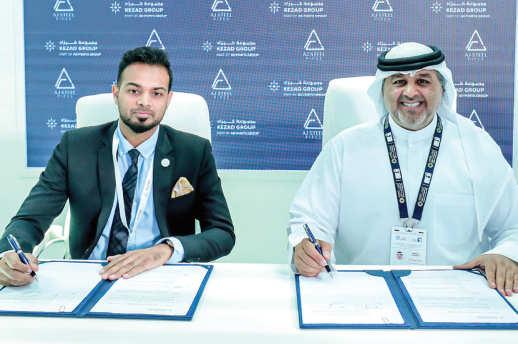
Photo Credit : AJ Steel
AJ Steel plans to enhance its production capacity.
EGA reaches 40 million tonne milestone
EMIRATES GLOBAL ALUMINIUM, the largest industrial company in the United Arab Emirates outside oil and gas, has reached the milestone of 40 million tonnes of hot metal produced since startup in 1979.
This means nearly 3% of all the aluminium ever made has been produced by EGA in the UAE.
Aluminium is an essential material for human progress, and EGA’s metal is used by billions of people worldwide as part of everything from skyscrapers to smartphones.
EGA’s development since the 1970s has made the UAE the fifth largest aluminium producing nation in the world. EGA’s aluminium is the biggest madeintheUAE export after oil and gas and is shipped to more than 50 countries. The aluminium sector with EGA at its heart accounts for 1.5% of the entire UAE economy.
It took almost 30 years for EGA to reach its first 10 million tonnes of production. In the past decade EGA’s growth has accelerated, transforming the company into a global integrated aluminium giant. Last year, EGA sold 2.54 million tonnes of cast metal.
Abdulnasser Bin Kalban, chief executive officer of EGA, said, “Reaching 40 million tonnes of hot metal production is a proud moment for everyone who works at EGA. Together, we have innovated aluminium to make modern life possible. Since EGA was founded by HH Sheikh Rashid as Dubai Aluminium, we have been a pioneer of economic diversification in the UAE while growing into a champion of the aluminium industry globally.”
EGA is the world’s biggest producer of ‘premium aluminium’, metal made to customer specifications including through alloying. EGA has produced more than 41.6 million tonnes of cast metal since 1979.
Last year, EGA became the first company in the world to make aluminium commercially using the power of the sun. EGA markets this metal under the product name CelestiAL. The use of solar power significantly reduces the emissions associated with aluminium smelting.
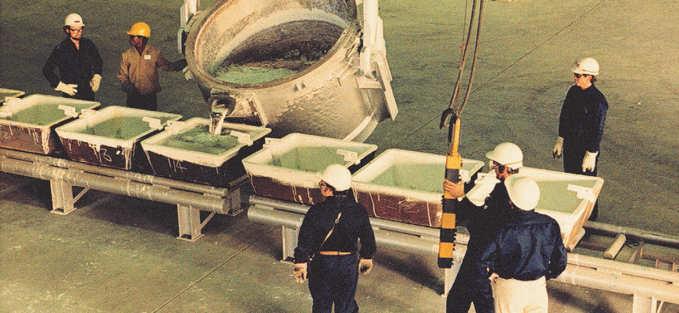
EGA is the world’s biggest producer of ‘premium aluminium’.
Photo Credit : EGA
Industry leaders discuss green credentials in real estate at COP 27
PROPERTY CONSULTANT SAVILLS Egypt, a part of Savills Middle East, hosted a panel discussion led by experts in sustainability and green energy. The focus was on the most pressing topics around the Environmental, Social, and Governance (ESG) factors, their cost, and the growth opportunities they present in the real estate industry against the backdrop of COP27 in Egypt. The real estate industry contributes to 40% of greenhouse gas emissions globally and is therefore an important sector for cities to consider when planning their paths to net zero.The panel was moderated by Catesby LangerPaget, head of Savills Egypt and included Madeleine Velupillai, ESG strategy manager at Savills UK; Nada El Agizy, the director of sustainable development and international cooperation at the Leagues of Arab States; Eng Bedeir Rizk, CEO of Paragon; Ahmad Badreldine, managing director of El Badr Group, and Mohamed Elsammaa, chief development officer of KarmSolar.
“Egypt is following the steps of other global economies in efforts to reduce the sector’s impact on climate change. There are currently 23 LEED (Leadership in Energy and Environmental Design) certified buildings in Egypt and we can definitely foresee this number increasing in the near future, particularly in the New Administrative Capital and new cities. We are currently working with our partners on their developments primarily commercial buildings that are currently under construction – seeking the LEED Platinum certification,” explained Catesby LangerPaget.
Madeleine Velupillai commented, “Proptech and smart building systems, as well as renewable and low energy technologies, can all help to improve a project’s green credentials. Research, development and property technologies will be crucial in helping to reduce emissions from the built environment as cities set their sights on net zero. Construction will therefore be at the forefront of this green building revolution, with forecasting and data analytics firm Oxford Economics suggesting that global construction output could reach US$15.2tn by 2030, up 42% from its 2020 level. The International Financial Cooperation estimates that green buildings represent a US$24.7 tn investment opportunity by 2030 across cities in emerging markets”.
Nada Al Agizy said, “We need to join forces in encouraging Arab countries to apply green building codes in order to accelerate the implementation of SDG 11, "Make cities and human settlements inclusive, safe, resilient and sustainable, to further support the transformation of societies and institutional and urban structures towards sustainability.”
Eng Bedeir Rizk commented, “Paragon is one of the leading companies specialising in building administrative projects with a philosophical methodology based on humancentric approach, sustainable principles, innovation, and flexible community. Promoting real estate with a smarter sustainable design and using technology to achieve the highest standards of productivity and comfort for customers in their workplace and creating an administrative society that provides an inspiring environment for growth has become the company’s approach on the buildings.”
Mohamed Elsammaa, chief development officer of KarmSolar, said, “KarmSolar’s expertise in the solar energy sector has allowed us to build multiple areas of synergy with real estate developers. Our goal for this panel is to begin the discussions on evaluating the different ways in which we can build financially feasible business models and become a true utility platform. Achieving ESG goals while positively impacting the profitability of the business is the true driver of growth and unlocking of value that the industry needs in order to increase the number of sustainablybuilt projects and communities.
Ahmad Badreldin said, “We strongly believe that the government can play a vital role in creating incentives to encourage real estate developers to be more sustainable. At Badreldin Group, we empower communities, thrive to set market trends, and innovate urban concepts while incorporating sustainable, green, and innovative measures. For Arkan and 205 projects, we have provided energy efficient designs and created an internal energy efficient transport network since it became a mandate to overcome energy cost increases.”
In recent years, the government has taken economic and environmental measures that played a major role in stimulating investments, investing US$324bn to achieve sustainable development initiatives to reduce emissions and improve infrastructure. Sustainability in real estate projects implemented by the private sector has become part of the culture of most real estate developers working in the Egyptian market, which amounts to around 20% of the country’s GDP. The state has taken this approach in all cities, either by working to establish them during the recent period, or revamping existing cities that have been established decades ago.

The real estate industry contributes to 40% of greenhouse gas emissions globally.
Quality assurance transforms the application of 3D printing
3D PRINTING, ALSO known as additive manufacturing, is transforming the oil and gas supply chain, increasing efficiencies and reducing costs according to Protolabs, a digital manufacturer.
The Middle East oil and gas 3D printing market is advancing rapidly as equipment manufacturers and suppliers benefit from its many advantages. These include greater flexibility in parts designs, a reduction in product development time, fewer resource requirements and leaner inventories. The technology and quality regimes have now evolved to make 3D Printing a viable manufacturing technology for mainstream use.
Research suggests the oil and gas 3D printing market will represent a US$2 bn opportunity by 2029. The World Economic Forum has estimated 3D printing could eventually save up to US$30bn of additional value for the industry.
Protolabs’ director of metal 3D printing, Dr Christoph Erhardt discussed ‘Advances in Manufacturing Technology, Transformation of the Oil & Gas Supply Chain through the Use of Additive Manufacturing’ at the ADIPEC 2022 Smart Manufacturing Technical Conference,
Dr Erhardt’s mentioned the rapid developments in additive manufacturing, and how material development and certification of the manufacturing process are helping to digitise the supply chain.
He highlighted how 3D printing and increased digitalisation are transforming inventory supplies, offering a more costeffective and efficient way of delivering critical components. What organisations need to consider with 3D printing and the benefits it can bring, were also examined.
Dr Erhardt said, "Spare parts and inventory supplies are critical in ensuring the safe and efficient operation of oil and gas assets across the globe. However, the burden this places on organisations to ensure redundancy of supply, logistics and storage increases their costs. This is encouraging the search for more effective ways to support operations without impacting performance. "The demand for 3D printing is growing in the oil and gas industry as companies recognise its operational, financial and environmental benefits. In the Middle East, suppliers and operators are already gaining value from the rapid and accurate generation of components, less downtime due to justintime part availability and a lower carbon footprint through reduced transport and manufacturing emissions.“
Last year, Protolabs secured the Qualification of Manufacturer certification from the independent risk management and assurance expert DNV.
The certification applies to Protolabs’ DMLS technology, specifically for the superalloy Inconel 718 – a highstrength, corrosionresistant nickel chromium. Combining the exceptional properties of the material with Protolabs’ expertise in DMLS enables the company to rapidly produce complex and longlasting parts for high temperature or harsh offshore and onshore environments.
Protolabs offers a variety of materials and technologies for the oil and gas, maritime and offshore industries, as well as the broader energy sector.
The technologyenabled company offers advanced 3D printing, injection moulding and CNC machining to product developers, engineers, and supply chain teams across the globe.
Using inhouse production capabilities and access to a team of service line experts, Protolabs helps companies bring new ideas to market at unprecedented speed and strategically manage demand volatility across the entire product lifecycle.
Photo Credit : Protolabs
Director of metal printing, Protolabs, Dr Christoph Erhardt.

Siemens and Eplan enter into strategic partnership
SIEMENS SMART INFRASTRUCTURE and Eplan have agreed to collaborate in the area of software solutions for the industry and infrastructure market segments.
As part of this partnership, Siemens' Electrical Products business unit will join the Eplan Partner Network as a strategic partner. The goal is to harmonise the two companies' products in a more targeted way to provide optimised solutions to switchgear manufacturers and electrical planners. Sebastian Seitz, CEO of Eplan, and Andreas Matte, CEO of electrical products at Siemens Intelligent Infrastructure, signed an agreement to this effect on September 26, 2022.
“The overall goal of our collaboration is to create a plugandplay structure for electrical planners. We want to open up our tools in both directions, thus simplifying and accelerating the workflow,” said Andreas Matte.
Sebastian Seitz of Eplan also emphasised the benefits of joint customers, “When constructing the switchgear, we can use the Eplan Pro Panel to greatly improve and automate operations. Plus we will specifically address the growing field of power distribution and work with Siemens to create endtoend solutions for an integrated workflow and more. efficiency.”
In the market sector concerned with industry, Siemens and Eplan will intensify the cooperation that has existed for several years, for example, to provide Eplan data on all adapted Siemens products. For the infrastructure market, Siemens and Eplan have decided to optimise and automate customer processes together, for example in the Sivacon and Alpha (power distribution systems) environment by integrating Simaris (planning tools) and the Eplan platform.
Trends shaping sustainability innovation in the Middle East
AT THE FUTURE Investment Initiative in Riyadh, experts from global consultancy Bain & Company focused on innovations poised to have an impact on the sustainability of seven industries: advanced manufacturing services (AMS), retail, banking, energy, healthcare, consumer products and automotive.
They have highlighted the trends and innovations gaining momentum in a given sector.
3D printing explores and accelerates larger, more complex AMS projects The construction sector contributes a chunk of energyrelated CO2 emissions. However, 3D printing’s latest advances in printing new materials, including cement and metals, and in printing larger objects can reduce the use of natural resources and waste in the sector, while increasing efficiency. Construction 3D printing allows faster and more accurate construction of complex or bespoke items. Companies that use 3D printing to lower costs can save up to 15% of the typical cost of a project.

Efficiency in retail is fundamental, and AI more accurately monitors and reduces scope 3 emissions A large amount of retail emissions are scope 3 indirect emissions in their supply chain, making the industry one of the leading emitters in this class. While scope 1 covers direct emissions from sources owned by a company, and scope 2 focuses on emissions from the electricity and heating or cooling sources they buy, scope 3 is particularly complex to manage since it involves a system, much of which is beyond the retailer’s direct control. Technologies including artificial intelligence (AI) can help monitor the system’s carbon footprint, forecasting and reducing emissions by optimising internal operations and those of external partners.
Banks continue to create new forms of sustainable value As fintech rise, banks are always competing with digital natives. While banks have a relatively small direct environmental footprint, they greatly influence how companies and consumers act, invest and address their environmental footprints. Among consumers, the market for green products is growing quickly, and that means an enormous financing opportunity exists for lenders. Increasingly, regulators are also requiring banks to measure and disclose their environmental impact, a task sometimes made difficult by limited access to reliable portfolio data and consistent standards of measurement.
Investing beyond carbon is now fundamental and nonnegotiable for an entire portfoliolevel transformation by energy companies Expanding government interventions, incentives and subsidies, coupled with changing customer, investor and employee expectations have leading energy companies reinventing and diversifying to lower the amount of ‘humanmade’ greenhouse gas emissions that come from energy sources. Digitalisation is creating new opportunities for partnerships and innovative business models, but companies must balance several other critical issues too, including energy affordability, energy security, and expected return on investment. One aspect of energy giants’ multifaceted approach is the creation of corporate venture capital funds to access new energy technology.
Our complex and fundamental healthcare industry is addressing the need to foster the circular economy. To date, more than half of all plastic ever produced has become waste, and its production has a significant greenhouse gas footprint. A substantial portion of the world’s plastic waste comes from healthcare, the majority associated with lifesaving medicine and procedures. Recently the World Health Organisation estimated that the critical products needed to manage through a global pandemic have included 87,000 metric tons of personal protective equipment and 144,000 metric tons of syringes, needles, and other vaccine waste, as well as the chemical and plastic waste from more than 140mn test kits.
A systemic change toward a circular economy could help reduce waste without compromising care.
Food consumption and production habits are at the heart of ESG growth, with vertical farming and labgrown meat leading the way The global food system is incredibly successful, feeding 7.9bn people and generating a third of global GDP. But at the same time, it places a hefty burden on the environment, creating more than a quarter of all greenhouse gas emissions and contributing to deforestation and species extinction. New approaches to agriculture and eating, including vertical farming and labgrown meat, can reduce the amount of water and land required to produce the same or greater amounts of food. This decreases the need for longhaul transportation, chemicals and pesticides. Cultured meat, requiring less energy and water than traditionally farmed meats, can create significantly fewer emissions.
Photo Credit : Adobe Stock
Innovation is shaping sustainability in every industry.
The automotive industry is embracing air mobility enabled by changing regulations and societal acceptance Cities consume most of the world’s energy supply and highway vehicles release billions of tons of greenhouse gases into the atmosphere each year. Urban air mobility (UAM), transporting both goods and people and powered by drones, could decongest cities, reduce noise pollution, and help to decarbonise the energy sector. New technologies, such as electric propulsion and enhanced battery capacity, applied to vertical takeoff and landing systems make this technically possible.
The pace of sustainability innovation mandates a multidimensional approach to value chain transformation. Sustainability is a complex, interconnected, and evolving topic that requires constant evaluation. The pace of innovation is increasing, ESG inclusion is becoming fundamental, and tracking the complex ecosystem’s development is essential. It is important to continue to unpack these topics, exploring a multidimensional approach to innovation strategy, startup ecosystem engagement, venture capital investing, and business building.
The article is written by Tom De Waele, Middle East managing partner, Akram Alami, partner and Middle East ESG lead and Truc Mai Dupont Vohong, vice president, Bain & Company.
Al-Bahar collaborates with Lamprell for power solutions
MOHAMED ABDULRAHMAN AL-BAHAR, the authorised Cat®dealer for the UAE, Bahrain, Kuwait, Oman, and Qatar, has completed the commissioning of integrated power solutions for the first of the two new offshore jackup rigs building projects executed by Lamprell, the UAEbased rig builder and leading provider of services to the international energy sector.
Lamprell turned to AlBahar for Cat® generator sets after the company received a letter of intent from the International Maritime Industries (IMI) in December 2018 for the construction and delivery of two jackup drilling rigs, based on the proven LeTourneau Super 116E Selfelevating Mobile Offshore Drilling Unit (MODU) design. The decision to proceed with AlBahar and Caterpillar for their power needs was based on Lamprell’s previous experiences and trust built over a 15yearlong relationship that started in 2008, involving building 12 new jackups, one land rig, and over 30 repowers.
AlBahar and Caterpillar teams worked together with Lamprell right from the inception stage of the project to design the final power solution needed for the rigs, and in January 2020, when the order was formalised for Lamprell by IMI, Caterpillar and AlBahar were both ready with the customised solution required for each rig.
The primary challenge was the project timeline, which was demanding and coincided with the onset of the COVID pandemic, bringing in uncertainty and newer norms. The readytodeliver plan and customerfirst focus by AlBahar ensured all the generators for the rigs were shipped to Dubai ahead of schedule. Cooperation from a reliable manufacturer like Caterpillar helped enable a timely delivery.
Presently, the project status is on the final lap. Installation, startup, setting to work, and testing have already been completed on the first rig, and the second rig is being worked upon currently.
Commenting on the successful completion of the project, Mohamed El Kaddour, vice president of energy & transportation – AlBahar, stated, “As one of the authorised Caterpillar dealers in the region, Mohamed Abdulrahman AlBahar is proud to be a trusted and valued partner to Lamprell in their rig building programmes of offshore jackup rigs. This mutually beneficial relationship has been nurtured ever since Lamprell built their first rig in 2008 and we hope will extend in the future.”
Deepak Tummalapalli, territory manager, from Caterpillar, quoted, “In addition to making available worldclass products for the oil and gas industry, we offer technology solutions to help companies work more safely and efficiently by ensuring unmatched support in the field through a global dealer network.”
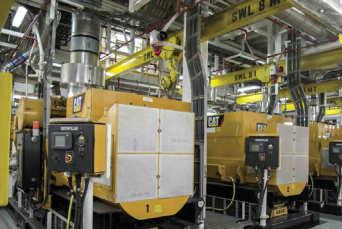
Photo Credit : Al ‐Bahar
Al‐Bahar and Caterpillar teams worked together with Lamprell right from the inception stage of the project to design the final power solution needed for the rigs.
Mitsubishi Power highlights hydrogen economy pathway to accelerate energy Transition
AS PART OF its commitment to a carbonneutral world, Mitsubishi Power, a power solutions brand of Mitsubishi Heavy Industries, Ltd. (MHI), participated in COP27, where it showcased its pioneering technology advances in decarbonisation and their application to accelerate the energy transition.
At COP27’s Hydrogen Transition Summit, Mitsubishi Power underscored the opportunity of hydrogen as a main enabler of energy transition, and as an integral constituent of a future decarbonised energy system.
In the opening session of the Summit, Javier Cavada, president and CEO of Europe, Middle East and Africa at Mitsubishi Power, highlighted the key role the MENA region can play in this regard. “The MENA region’s potential to become a major exporter of hydrogen, with the availability of abundant and lowcost renewables, existing export infrastructure, as well as financing resources.”
Dr Cavada also stressed the importance of collaboration to realise the potential of hydrogen. “While hydrogen will continue to play an essential role in decarbonisation, its widespread deployment will require unprecedented collaboration with both existing and new technologies, industry partners, policymakers, and NGOs.”
Demonstrating the brand’s commitment to realising a carbon neutral society, MHI is committed to achieve carbon neutrality across its operations by 2040. MHI is also adopting a new goal to achieve Net Zero emissions through its entire value chain by 2040. In line with this ambition, Mitsubishi Power continues to develop energy solutions and processes that enable hydrogen’s transition from industrial use to being the clean fuel of choice.
“Since 1970, Mitsubishi Power has pioneered hydrogen fuel combustion technologies. With our recent projects that have demonstrated the largescale commercial validation of our technology and decadeslong expertise in this field, we are committed to support our customers across the region accelerate their energy transition with affordable and reliable solutions. This is going to be essential to demonstrating how hydrogen can competitively fulfil clean energy expectations and bring us one step closer towards a carbon neutral society,” added Cavada.
One recent example is the full turnkey contract Mitsubishi Power signed with leading Egyptian oil & gas company, Alexandria National Refining & Petrochemicals Company (ANRPC), to provide advanced hydrogen fuel conversion technology solutions, supporting the company to achieve its decarbonisation goals. The solution will be installed at the ARNPC refinery plant in Alexandria, which provides 30% of Egypt’s gasoline supply for domestic consumption.
“Decarbonisation will be achieved by focusing on increasing energy efficiency and collaborating closely to develop and scale up hydrogen and CO2 value chains. There is no onesizefitsall approach to net zero 2050 — different regions and sectors will choose different pathways,” said Dr Emmanouil Kakaras, executive vice president, Next Energy Business at MHI EMEA, who also participated in Climate Action’s Sustainable Innovation Forum
Trina Solar unveils solution for utility-scale projects
TRINA SOLAR, THE global PV and smart energy total solutions provider, has unveiled the Vertex N 595W for C&I and utilityscale projects. Together with the Vertex N 690W for utility scenarios and Vertex S+ 445W for rooftop PV systems, Trina Solar’s ntype module portfolio is based on the 210 product technology platform and ntype iTOPCon cell technology. The release of Vertex N will hit and reshape the PV market again.
Antonio Jimenez, managing director and vice president, Middle East, Trina Solar commented, “Bringing the latest Vertex Modules to the Middle East and Africa region comes as part of our ongoing commitment to introduce the latest technologies and innovative products and solutions to its clients here. We are confident that the Vertex N 595W modules will not only revolutionize the industry, but also set new standards and benchmarks that are yet to be matched.” Vertex N 595W is ready for delivery The newly announced Vertex N module, inheriting the Vertex family’s merits of higher power, higher efficiency, higher energy yield and higher reliability, boasts maximum power output of 595W, 30W higher than conventional ntype modules in the market. In addition, this dualglass module increases bifaciality to 80% and delivers higher efficiency, lower degradation and better energy yield, delivering lower BOS and LCOE to projects.
Against the backdrop of greater grid parity, increasing solar demand and rising market share, the latest ntype module portfolio, with power output ranging from 445W to 690W, will cement the modules as preeminent products for rooftops and utilityscale projects.
The new generation of Vertex N modules will be in mass production by the end of 2022 and more than 10 GW ntype modules capacity are expected to be released by the first quarter of 2023. Moreover, capacity of ntype modules will reach 20GW to 30GW by the end of next year. To meet the increasing demand for ultrahigh performance modules, Trina Solar will continue to develop and promote more ntype products.
As a first mover in the field of 210 product technology, Trina Solar is committed to building an open platform that is compatible with most cuttingedge cell technologies, such as iTOPCon and HJT.
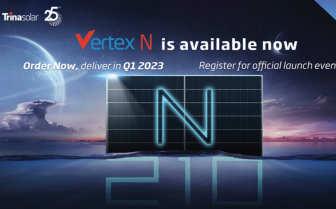
Trina Solar’s n‐type module portfolio is based on the 210 product technology platform and n‐type i‐TOPCon cell technology.
EEHC’s GE LM6000 unit generates power using hydrogen-blended fuel
HE DR MOHAMED Shaker ElMarkabi, Minister of Electricity and Renewable Energy of Egypt, announced the successful operation of a GE LM6000 aeroderivative gas turbine on hydrogen – natural gas blended fuel at the Sharm El Sheikh Power Plant. The demonstrations of the unit running on the mixed fuel ran at different times during the United Nations Framework Convention on Climate Change’s (UNFCCC’s) 27th session of the Conference of the Parties (COP27), termed the ‘Implementation COP’.
A proof of concept, the project illustrates that it is, in fact, possible to generate lower carbon, reliable, on demand power by burning hydrogenblended fuels in gas turbines. The project was executed less than five months after a strategic cooperation agreement was signed by Egyptian Electricity Holding Company (EEHC), GE, Hassan Allam Construction, and PGESCO. It is the first time that GE’s LM6000 gas turbine was run on hydrogenblended fuel on the African continent
HE Dr Mohamed Shaker ElMarkabi said, “We must all take urgent actions to address the climate challenge. We need to act today – not years from now – to invest in solutions that can provide lower carbon energy, and Egypt is wellpositioned to play a leading role in this energy transition. Today, as I announce the successful operation of a GE LM6000 aeroderivative gas turbine on hydrogenblended fuel right here in the city of Sharm El Sheikh during Energy Day at COP27, the world can see what is possible when you bring big dreams, strong resolve, and committed partners together. The combination of EEHC’s commitment and facilitation, GE’s global, industryleading expertise in hydrogenfueled power projects, and Hassan Allam and PGESCO’s strong ontheground construction and engineering capabilities, led to the extraordinary achievement of the safe, on time, and successful completion of this demonstration pilot.”
EEHC owns and operates the Sharm El Sheikh Power Plant. GE led the conception, planning, and execution of the project, as well as the building of the hydrogennatural gas blending system. Hassan Allam supplied the manpower and equipment needed for installation, related civil works, hydrogen needed for testing, and the piping and cabling system that transported hydrogen to the mixing skid and the turbine. PGESCO helped design the project and provided engineering expertise.
“We commend the strong actions being taken by the Government of Egypt to bring the world together at COP27 to remain focused on creating a lower carbon energy future,” said Joseph Anis, president and CEO of GE Gas Power in Europe, Middle East, and Africa. “GE is committed to collaborating closely with the government of Egypt, as well as other customers and partners to address the climate challenge. We were honored to design the overall hydrogennatural gas demonstration project at Sharm El Sheikh; identify various parties to lead engineering, procurement, construction, hydrogen supply, safety initiatives, and other works; provide the critical blending skids needed to mix the hydrogen and natural gas; and then drive coordination efforts among all parties involved to bring the project to successful completion. This is an excellent example of what it means to be together for implementation.”
GE has more than 30 years of experience with over 100 gas turbines that have operated on fuels that contain hydrogen globally, accumulating more than 8 million operating hours. Earlier in 2021, GE announced a collaboration in North America to run an LM6000 unit on a blend of hydrogen and natural gas. Learnings from the project were applied by GE at Sharm El Sheikh and shared with other project partners, leading not just to the successful completion of the project, but also to a significant transfer of knowledge and local capacity building in the utilisation of hydrogen as a fuel for power generation.









